instrument panel Alfa Romeo 8C 2010 Owner handbook (in English)
[x] Cancel search | Manufacturer: ALFA ROMEO, Model Year: 2010, Model line: 8C, Model: Alfa Romeo 8C 2010Pages: 223, PDF Size: 14.35 MB
Page 16 of 223
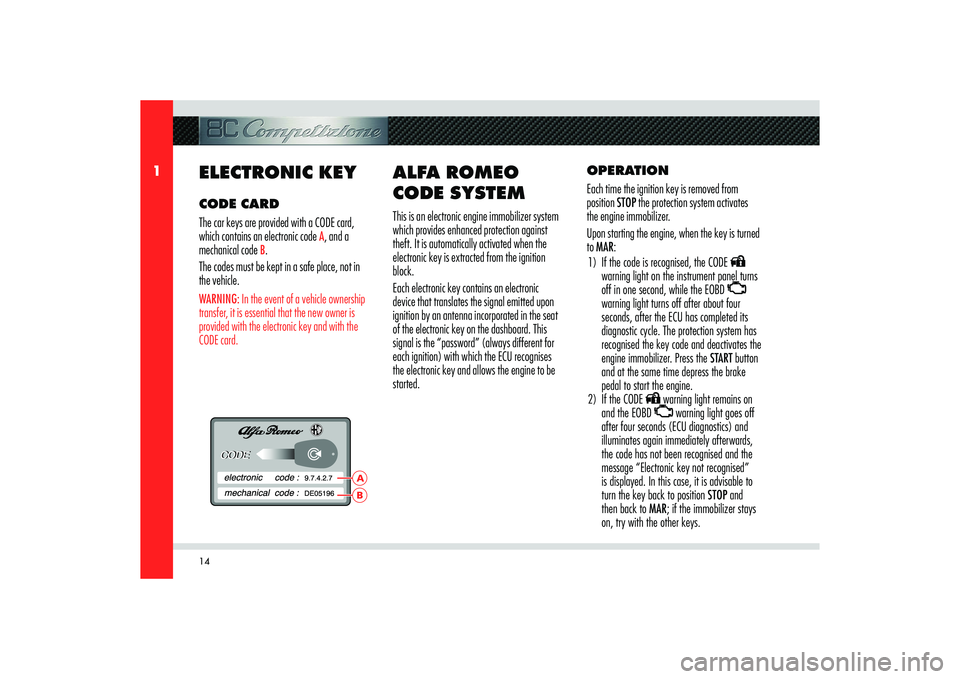
14
1
BA
ELECTRONIC KEYCODE CARD
The car keys are provided with a CODE card,
which contains an electronic code
A, and a
mechanical code
B.
The codes must be kept in a safe place, not in
the vehicle.
WARNING: In the event of a vehicle ownership
transfer, it is essential that the new owner is
provided with the electronic key and with the
CODE card.
ALFA ROMEO
CODE SYSTEMThis is an electronic engine immobilizer system
which provides enhanced protection against
theft. It is automatically activated when the
electronic key is extracted from the ignition
block.
Each electronic key contains an electronic
device that translates the signal emitted upon
ignition by an antenna incorporated in the seat
of the electronic key on the dashboard. This
signal is the “password” (always different for
each ignition) with which the ECU recognises
the electronic key and allows the engine to be
started.OPERATION
Each time the ignition key is removed from
position STOP the protection system activates
the engine immobilizer.
Upon starting the engine, when the key is turned
to MAR:
1) If the code is recognised, the CODE
warning light on the instrument panel turns
off in one second, while the EOBD
warning light turns off after about four
seconds, after the ECU has completed its
diagnostic cycle. The protection system has
recognised the key code and deactivates the
engine immobilizer. Press the START button
and at the same time depress the brake
pedal to start the engine.
2) If the CODE warning light remains on
and the EOBD warning light goes off
after four seconds (ECU diagnostics) and
illuminates again immediately afterwards,
the code has not been recognised and the
message “Electronic key not recognised”
is displayed. In this case, it is advisable to
turn the key back to position STOP and
then back to MAR; if the immobilizer stays
on, try with the other keys.
Page 20 of 223
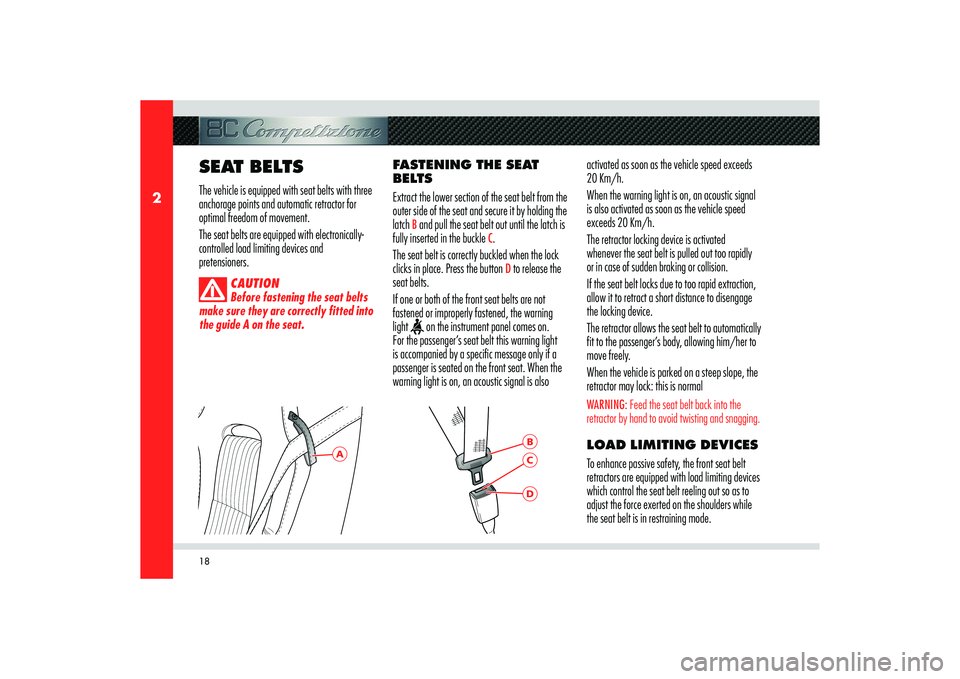
18
2
A
BDC
SEAT BELTS The vehicle is equipped with seat belts with three
anchorage points and automatic retractor for
optimal freedom of movement.
The seat belts are equipped with electronically-
controlled load limiting devices and
pretensioners.
CAUTION
Before fastening the seat belts
make sure they are correctly fitted into
the guide A on the seat.
FASTENING THE SEAT
BELTS
Extract the lower section of the seat belt from the
outer side of the seat and secure it by holding the
latch
B and pull the seat belt out until the latch is
fully inserted in the buckle
C.
The seat belt is correctly buckled when the lock
clicks in place. Press the button
D to release the
seat belts.
If one or both of the front seat belts are not
fastened or improperly fastened, the warning
light
on the instrument panel comes on.
For the passenger’s seat belt this warning light
is accompanied by a specific message only if a
passenger is seated on the front seat. When the
warning light is on, an acoustic signal is also activated as soon as the vehicle speed exceeds
20 Km/h.
When the warning light is on, an acoustic signal
is also activated as soon as the vehicle speed
exceeds 20 Km/h.
The retractor locking device is activated
whenever the seat belt is pulled out too rapidly
or in case of sudden braking or collision.
If the seat belt locks due to too rapid extraction,
allow it to retract a short distance to disengage
the locking device.
The retractor allows the seat belt to automatically
fit to the passenger’s body, allowing him/her to
move freely.
When the vehicle is parked on a steep slope, the
retractor may lock: this is normal
WARNING: Feed the seat belt back into the
retractor by hand to avoid twisting and snagging.LOAD LIMITING DEVICES
To enhance passive safety, the front seat belt
retractors are equipped with load limiting devices
which control the seat belt reeling out so as to
adjust the force exerted on the shoulders while
the seat belt is in restraining mode.
Page 35 of 223
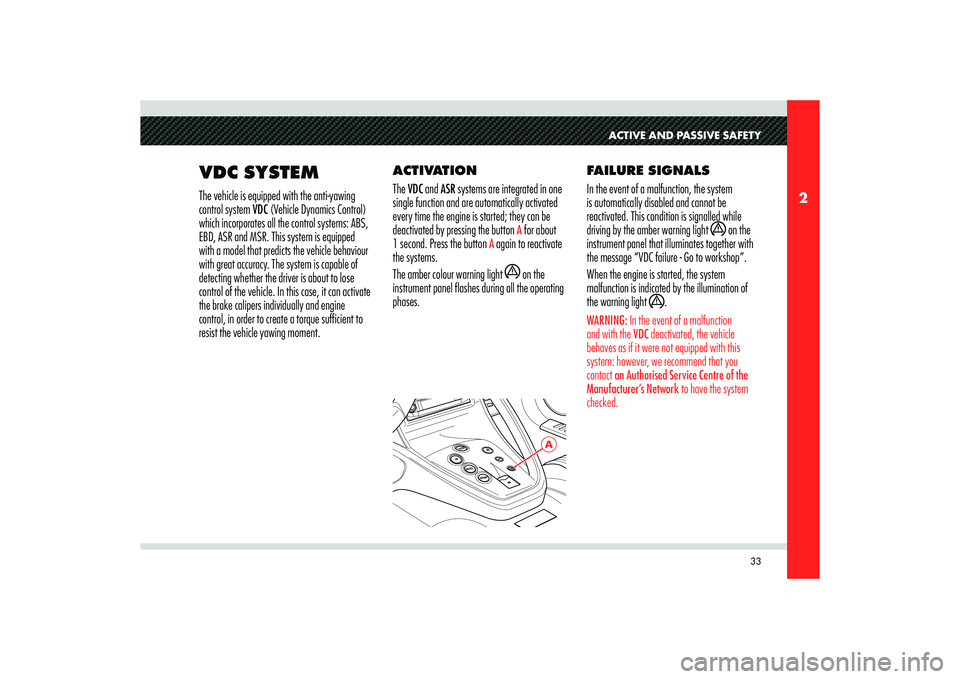
33
2
A
ACTIVE AND PASSIVE SAFETY
VDC SYSTEMThe vehicle is equipped with the anti-yawing
control system VDC (Vehicle Dynamics Control)
which incorporates all the control systems: ABS,
EBD, ASR and MSR. This system is equipped
with a model that predicts the vehicle behaviour
with great accuracy. The system is capable of
detecting whether the driver is about to lose
control of the vehicle. In this case, it can activate
the brake calipers individually and engine
control, in order to create a torque sufficient to
resist the vehicle yawing moment.ACTIVATION
The VDC and ASR systems are integrated in one
single function and are automatically activated
every time the engine is started; they can be
deactivated by pressing the button
A for about
1 second. Press the button
A again to reactivate
the systems.
The amber colour warning light
on the
instrument panel flashes during all the operating
phases.FAILURE SIGNALS
In the event of a malfunction, the system
is automatically disabled and cannot be
reactivated. This condition is signalled while
driving by the amber warning light on the
instrument panel that illuminates together with
the message “VDC failure - Go to workshop”.
When the engine is started, the system
malfunction is indicated by the illumination of
the warning light .
WARNING: In the event of a malfunction
and with the VDC deactivated, the vehicle
behaves as if it were not equipped with this
system: however, we recommend that you
contact an Authorised Service Centre of the
Manufacturer’s Network to have the system
checked.
Page 36 of 223
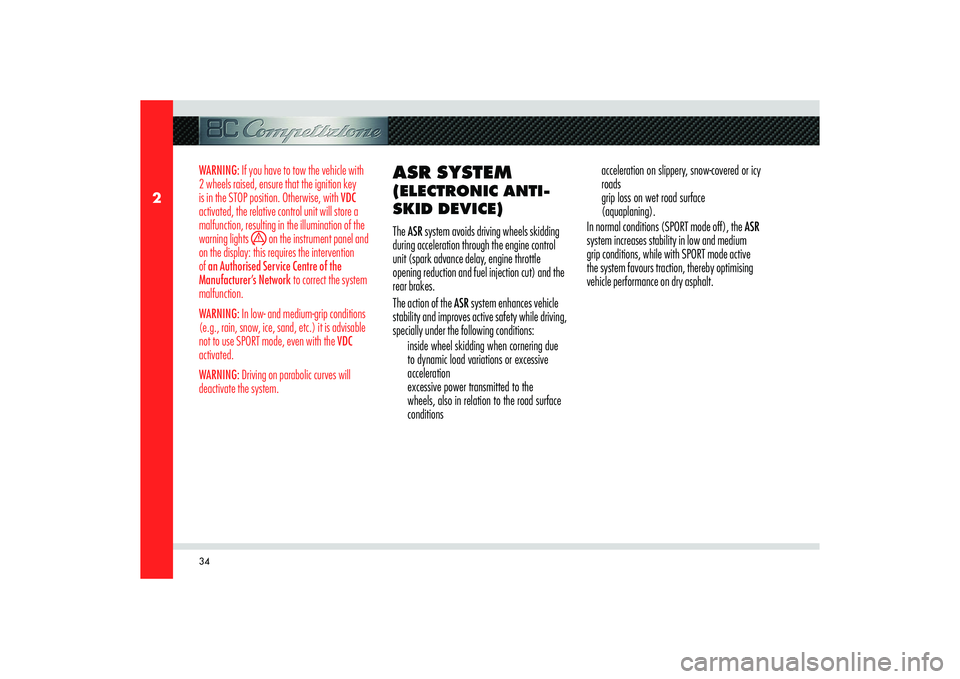
34
2
WARNING: If you have to tow the vehicle with
2 wheels raised, ensure that the ignition key
is in the STOP position. Otherwise, with VDC
activated, the relative control unit will store a
malfunction, resulting in the illumination of the
warning lights
on the instrument panel and
on the display: this requires the intervention
of an Authorised Service Centre of the
Manufacturer’s Network to correct the system
malfunction.
WARNING: In low- and medium-grip conditions
(e.g., rain, snow, ice, sand, etc.) it is advisable
not to use SPORT mode, even with the VDC
activated.
WARNING: Driving on parabolic curves will
deactivate the system.
ASR SYSTEM (ELECTRONIC ANTI-
SKID DEVICE)The ASR system avoids driving wheels skidding
during acceleration through the engine control
unit (spark advance delay, engine throttle
opening reduction and fuel injection cut) and the
rear brakes.
The action of the ASR system enhances vehicle
stability and improves active safety while driving,
specially under the following conditions:
inside wheel skidding when cornering due
to dynamic load variations or excessive
acceleration
excessive power transmitted to the
wheels, also in relation to the road surface
conditions acceleration on slippery, snow-covered or icy
roads
grip loss on wet road surface
(aquaplaning).
In normal conditions (SPORT mode off), the ASR
system increases stability in low and medium
grip conditions, while with SPORT mode active
the system favours traction, thereby optimising
vehicle performance on dry asphalt.
Page 37 of 223
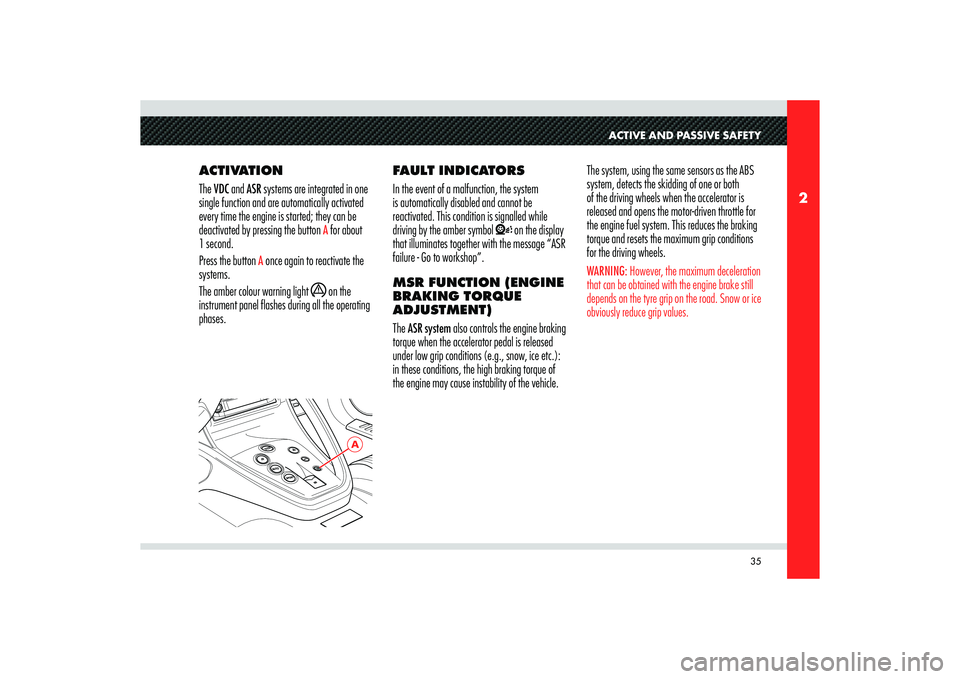
35
2
A
ACTIVE AND PASSIVE SAFETY
ACTIVATION
The VDC and ASR systems are integrated in one
single function and are automatically activated
every time the engine is started; they can be
deactivated by pressing the button
A for about
1 second.
Press the button
A once again to reactivate the
systems.
The amber colour warning light
on the
instrument panel flashes during all the operating
phases.FAULT INDICATORS
In the event of a malfunction, the system
is automatically disabled and cannot be
reactivated. This condition is signalled while
driving by the amber symbol
on the display
that illuminates together with the message “ASR
failure - Go to workshop”.
MSR FUNCTION (ENGINE
BRAKING TORQUE
ADJUSTMENT)
The ASR system also controls the engine braking
torque when the accelerator pedal is released
under low grip conditions (e.g., snow, ice etc.):
in these conditions, the high braking torque of
the engine may cause instability of the vehicle.The system, using the same sensors as the ABS
system, detects the skidding of one or both
of the driving wheels when the accelerator is
released and opens the motor-driven throttle for
the engine fuel system. This reduces the braking
torque and resets the maximum grip conditions
for the driving wheels.
WARNING: However, the maximum deceleration
that can be obtained with the engine brake still
depends on the tyre grip on the road. Snow or ice
obviously reduce grip values.
Page 38 of 223
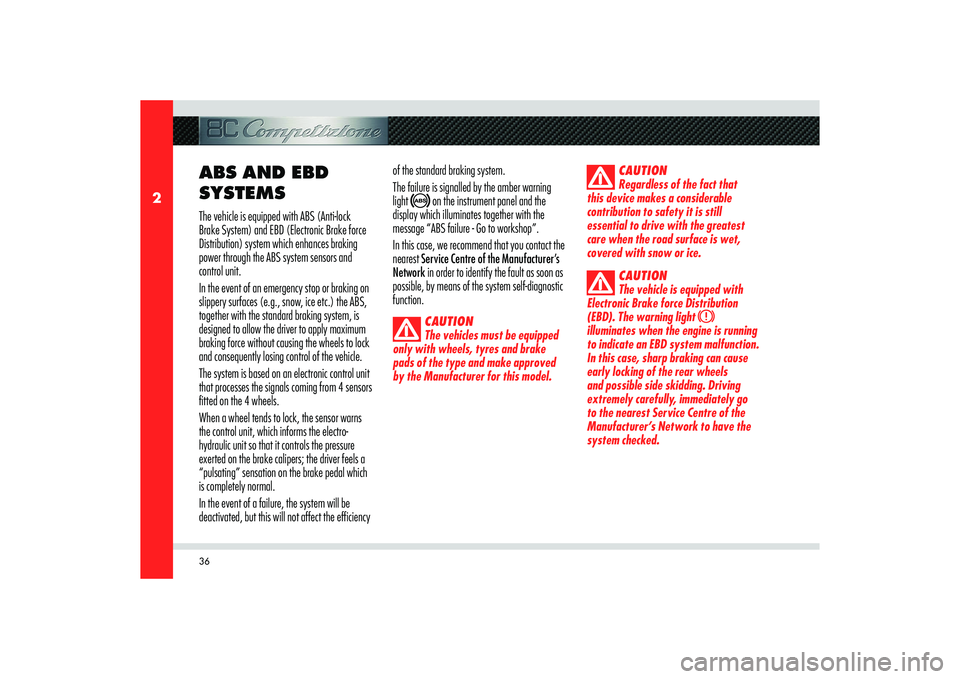
36
2
ABS AND EBD
SYSTEMSThe vehicle is equipped with ABS (Anti-lock
Brake System) and EBD (Electronic Brake force
Distribution) system which enhances braking
power through the ABS system sensors and
control unit.
In the event of an emergency stop or braking on
slippery surfaces (e.g., snow, ice etc.) the ABS,
together with the standard braking system, is
designed to allow the driver to apply maximum
braking force without causing the wheels to lock
and consequently losing control of the vehicle.
The system is based on an electronic control unit
that processes the signals coming from 4 sensors
fitted on the 4 wheels.
When a wheel tends to lock, the sensor warns
the control unit, which informs the electro-
hydraulic unit so that it controls the pressure
exerted on the brake calipers; the driver feels a
“pulsating” sensation on the brake pedal which
is completely normal.
In the event of a failure, the system will be
deactivated, but this will not affect the efficiency of the standard braking system.
The failure is signalled by the amber warning
light
on the instrument panel and the
display which illuminates together with the
message “ABS failure - Go to workshop”.
In this case, we recommend that you contact the
nearest Service Centre of the Manufacturer’s
Network in order to identify the fault as soon as
possible, by means of the system self-diagnostic
function.CAUTION
The vehicles must be equipped
only with wheels, tyres and brake
pads of the type and make approved
by the Manufacturer for this model.CAUTION
Regardless of the fact that
this device makes a considerable
contribution to safety it is still
essential to drive with the greatest
care when the road surface is wet,
covered with snow or ice.
CAUTION
The vehicle is equipped with
Electronic Brake force Distribution
(EBD). The warning light
illuminates when the engine is running
to indicate an EBD system malfunction.
In this case, sharp braking can cause
early locking of the rear wheels
and possible side skidding. Driving
extremely carefully, immediately go
to the nearest Service Centre of the
Manufacturer’s Network to have the
system checked.
Page 43 of 223
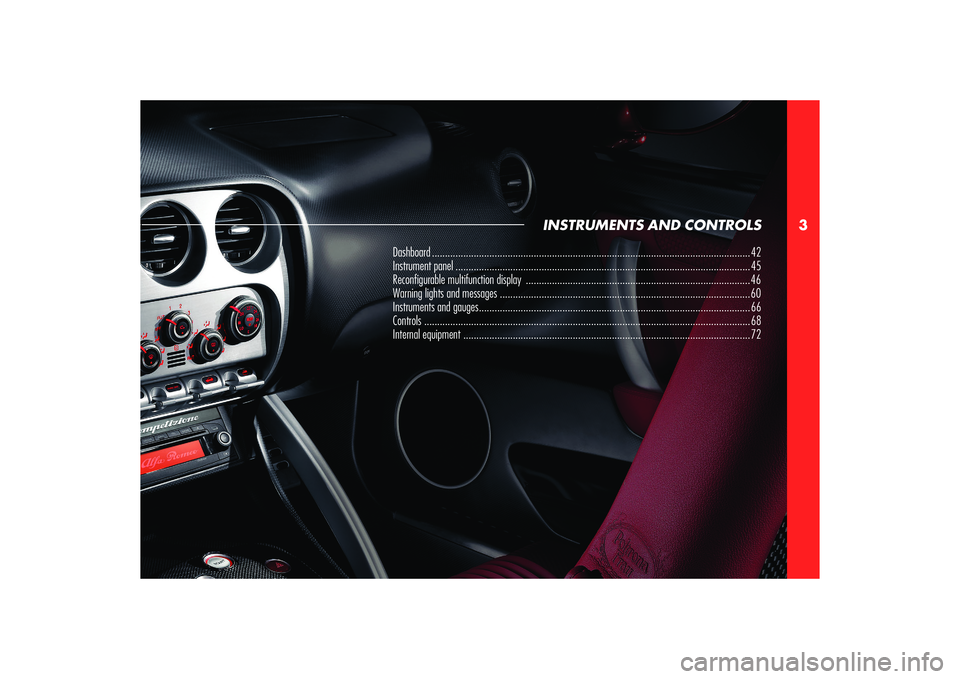
3
INSTRUMENTS AND CONTROLS
Dashboard .......................................................................................................................... 42
Instrument panel ................................................................................................................. 45
Reconfi gurable multifunction display ...................................................................................... 46
Warning lights and messages ................................................................................................ 60
Instruments and gauges ........................................................................................................66
Controls ............................................................................................................................. 68
Internal equipment .............................................................................................................. 72
Page 45 of 223
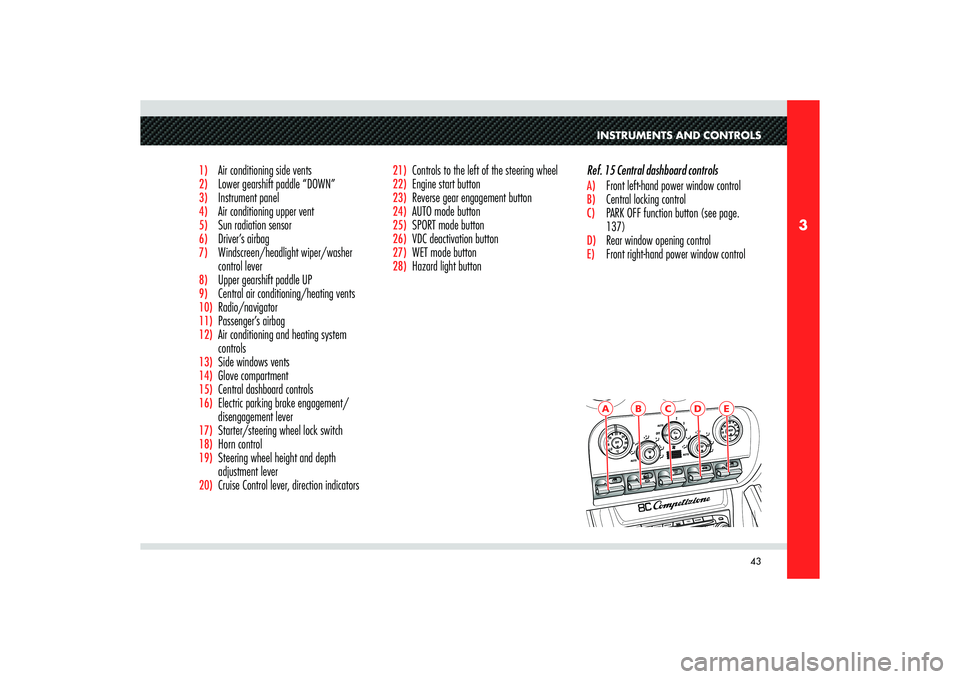
43
3
A
B
C
D
E
INSTRUMENTS AND CONTROLS
1) Air conditioning side vents2) Lower gearshift paddle “DOWN”3) Instrument panel4) Air conditioning upper vent5)
Sun radiation sensor
6)
Driver’s airbag
7)
Windscreen/headlight wiper/washer
control lever
8)
Upper gearshift paddle UP
9)
Central air conditioning/heating vents
10)
Radio/navigator
11)
Passenger’s airbag
12)
Air conditioning and heating system
controls
13)
Side windows vents
14)
Glove compartment
15)
Central dashboard controls
16)
Electric parking brake engagement/
disengagement lever
17)
Starter/steering wheel lock switch
18)
Horn control
19)
Steering wheel height and depth
adjustment lever
20)
Cruise Control lever, direction indicators
21)
Controls to the left of the steering wheel
22)
Engine start button
23)
Reverse gear engagement button
24)
AUTO mode button
25)
SPORT mode button
26)
VDC deactivation button
27)
WET mode button
28)
Hazard light buttonRef. 15 Central dashboard controls
A) Front left-hand power window controlB) Central locking control C) PARK OFF function button (see page.
137)D) Rear window opening control E) Front right-hand power window control
Page 46 of 223
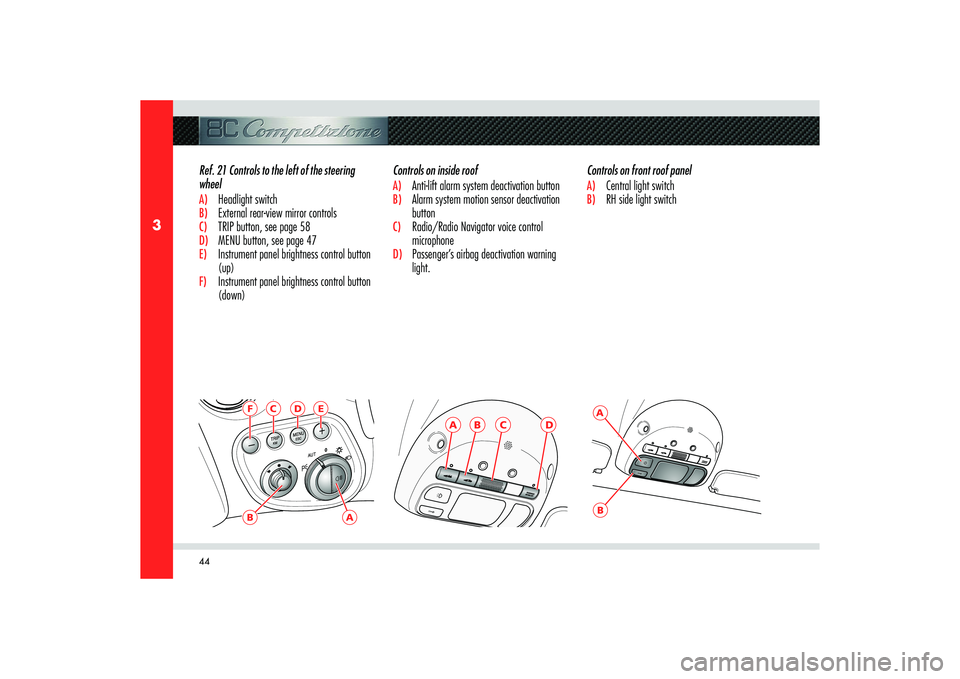
44
3
A
B
C
D
F
C
D
E
B
A
AB
Controls on inside roofA) Anti-lift alarm system deactivation buttonB) Alarm system motion sensor deactivation
buttonC) Radio/Radio Navigator voice control
microphoneD) Passenger’s airbag deactivation warning
light. Ref. 21 Controls to the left of the steering
wheel
A) Headlight switchB) External rear-view mirror controlsC) TRIP button, see page 58D) MENU button, see page 47E) Instrument panel brightness control button
(up)F) Instrument panel brightness control button
(down)Controls on front roof panel
A) Central light switchB) RH side light switch
Page 47 of 223
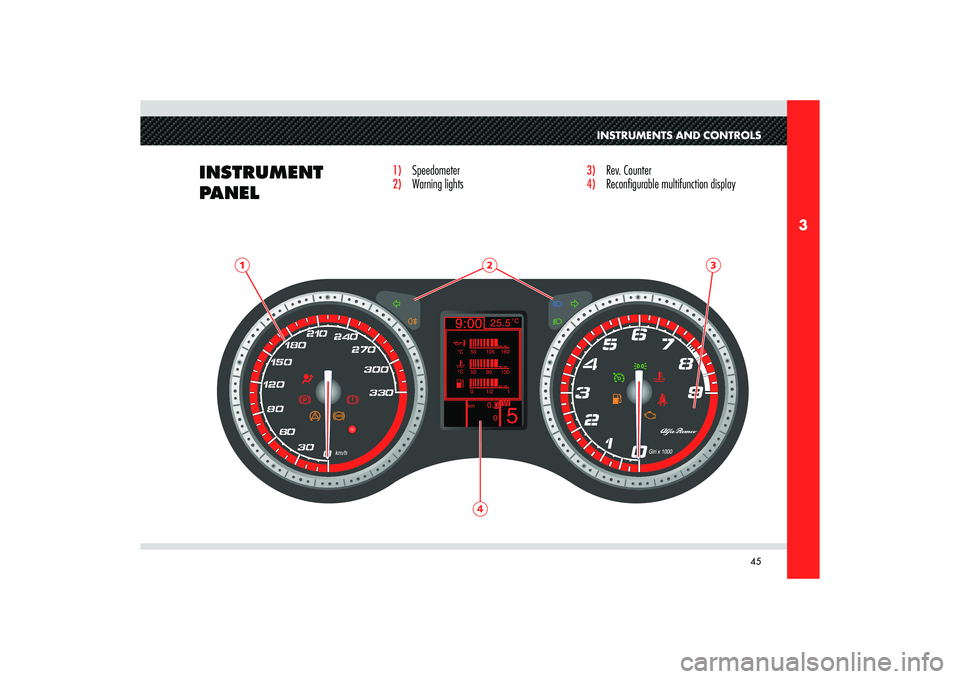
45
3
1
24
3
INSTRUMENTS AND CONTROLS
INSTRUMENT
PANEL
1) Speedometer 2) Warning lights
3)
Rev. Counter
4)
Reconfi gurable multifunction display